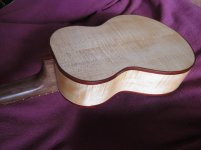fungusgeek
Well-known member
- Joined
- Oct 29, 2012
- Messages
- 98
- Reaction score
- 2
I am just starting out with uke building (much more experience with banjos) and, being an engineer type, I am fascinated by the number of variables that one can play with during construction. So, for my third and fourth ukes I built two simultaneously, with the same wood, the difference being that one uses a Kasha bracing system (based on Hana Lima 'Ia plans) and one uses the traditional fan bracing. Sides and back are maple I had cut some 30 years ago at a local sawmill (I have been carrying these big quarter sawn slabs around for a long time) and the tops are sitka spruce from dumpster diving at Martin Guitar also some 30 years ago. Walnut necks (bolt on), paduk binding (another thread on using paduk), some nameless tropical hardwood (Ziricote?) for the headplate on "Capricorn", fingerboard and bridges. Mammoth ivory for nut and saddle, various kinds of pearl.
Results:
They sound different. The tap tone of the tops and the bodies when assembled were quite different. The sound difference when strung up (low-G) does not sound as great as one might have expected from the tap tones. I am not a player (banjo yes, uke - working on it) so I do not have sound files right now (working on it). I did take them both over to a friend who plays and the results hearing him play were much more obvious than me just strumming away. Both sound pretty good, but based on my friends assessment the differences were:
fan braced - more of that traditional ukulele sound. Kind of plunky, a bit more treble, and as he put it, the sound was 'over there'. About the same overall volume as the Kasha bracing.
kasha braced - much more of a guitar-like sound. Deeper resonance, more base, and the sound was "in the instrument" to use my friends words. I find the Kasha sound to be more "open" (whatever that means, but it is the word that comes to mind).
Notes: "Capricorn" - the goat, is so named because when I put on the book-matched head plate it really looked like an animal to me. I just added some eye pupils and horns in abalone pearl and brown/white pearl. "Leaves" - pearl maple leaves on a curly maple headplate on a maple uke, seems fitting.
Next: How much difference does the back/side wood make? Going to build two with rosewood back and sides, spruce tops, Kasha and fan braced. Same thickness as these maple ones, and also a third rosewood one with a cedar top, probably Kasha braced.
Results:
They sound different. The tap tone of the tops and the bodies when assembled were quite different. The sound difference when strung up (low-G) does not sound as great as one might have expected from the tap tones. I am not a player (banjo yes, uke - working on it) so I do not have sound files right now (working on it). I did take them both over to a friend who plays and the results hearing him play were much more obvious than me just strumming away. Both sound pretty good, but based on my friends assessment the differences were:
fan braced - more of that traditional ukulele sound. Kind of plunky, a bit more treble, and as he put it, the sound was 'over there'. About the same overall volume as the Kasha bracing.
kasha braced - much more of a guitar-like sound. Deeper resonance, more base, and the sound was "in the instrument" to use my friends words. I find the Kasha sound to be more "open" (whatever that means, but it is the word that comes to mind).
Notes: "Capricorn" - the goat, is so named because when I put on the book-matched head plate it really looked like an animal to me. I just added some eye pupils and horns in abalone pearl and brown/white pearl. "Leaves" - pearl maple leaves on a curly maple headplate on a maple uke, seems fitting.
Next: How much difference does the back/side wood make? Going to build two with rosewood back and sides, spruce tops, Kasha and fan braced. Same thickness as these maple ones, and also a third rosewood one with a cedar top, probably Kasha braced.





